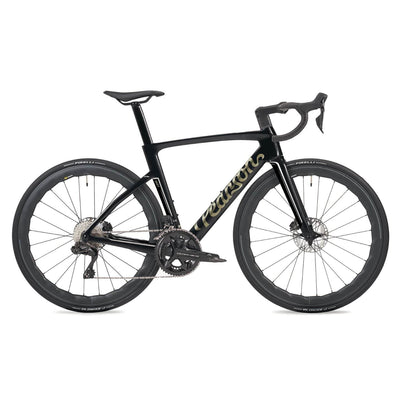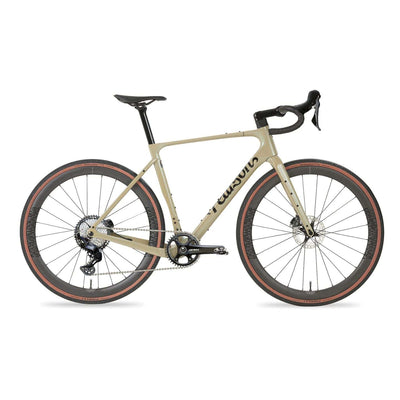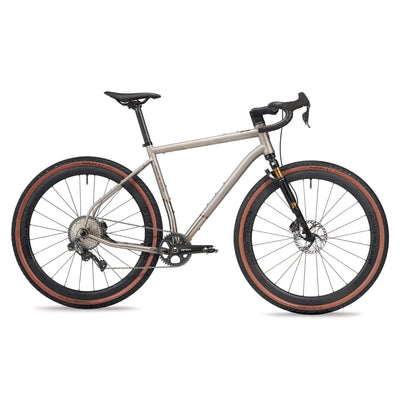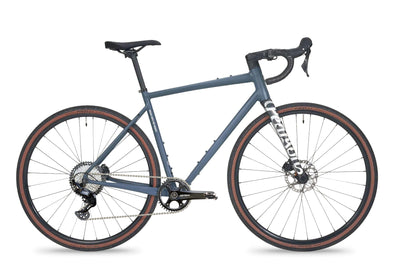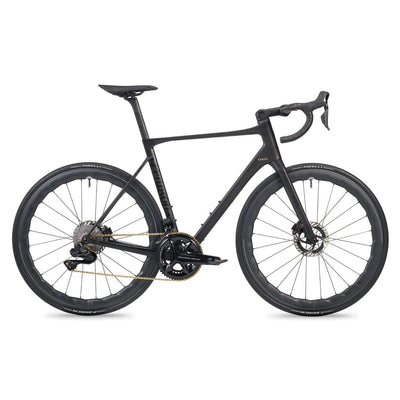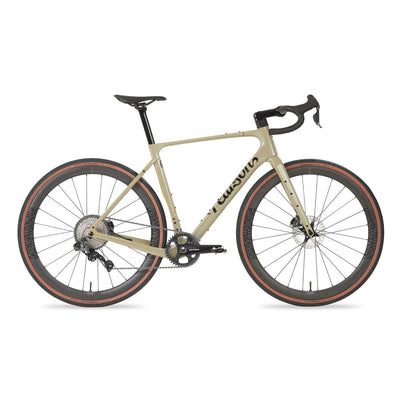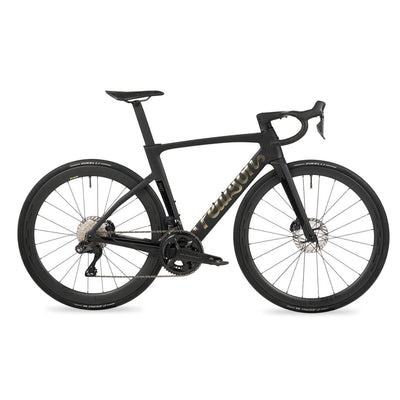COVERING THE ANGLES
Lead bike designer Scott Decker on the art (and science) behind the perfect Pearson bike.

The word is you’re a keen cyclist.
I’ve been riding bikes since I was four and have ridden most ‘genres’. It was BMX in my teens, mountain biking in my 20s, and road riding throughout; recently it’s included more gravel riding. My dad took us out for long bike rides when we were young and this instilled fun and enjoyment. I ride a bike every day, whether its running errands or picking up the kids from school. It might be a lunchtime loop on local lanes, or an all-out adventure on Dartmoor (I live in Devon). I don’t define myself by one cycling category and hopefully bring that varied experience into our finished products.
How long have you worked in cycling?
I’ve been in the industry for around 12 years. I studied industrial design at Brunel University but didn’t follow a design career initially. The opportunity to work with Pearson was too good to pass up. It combines my design skills with my passion for bikes, at the same time working for the oldest bike shop in the world.
With more bikes available than ever, is that a good thing?
Mass production has helped to increase bike use significantly but it comes with downsides to the customer. For example, the choice of components and general spec is often based on cost rather than quality, or the use of generic geometry. One thing much of the industry gets wrong is the overall fit and comfort for the end-user. Many bikes are designed with race teams in mind. The majority of these are being ridden by ordinary riders, people who don’t need to achieve the same position on a bike as, say, Mark Cavendish.
So, don’t buy the first bike you find online?
The increasing number of direct-to-consumer bikes isn’t particularly helpful. Two very different customers will often be sent the same size frame, with the same set-up. There’s little option to make changes, such as bar width or stem length. At Pearson, our bike-fitting specialists see the consequences of this, when customers come to us complaining about injuries or discomfort.

How are most mainstream bikes designed?
There are so many ways to produce bikes it’s difficult to say what ‘mainstream’ means these days. At one end of the spectrum, you can pick a model out of a factory catalogue; at the other you have a lengthy R&D process involving huge teams of engineers. For smaller brands there’s some compromises as they don’t have the economies of scale. The more tooling involved, for example, the higher the end-cost. You can order a bike which has been put together with very little thought for the end user; alternatively, you could end up with such specific components that it becomes a problem when a part breaks and you need to replace it.
How is the Pearson approach different?
The Pearson bike range is always evolving. Much depends on customer needs, of course, and we keep an eye on advances in components, on new production techniques and trends. Once we’ve decided a new model, we establish a design brief. We spend a lot of time on this stage to ensure we fully investigate the range of ‘use cases’ – ie what the bike is for. From this process we’ll end up with a pretty finely tuned idea of the specifics of the bike, from the geometry and ride-feel, to components and aesthetics. Only then do we set about designing the bike, a process which obviously includes other variables; a carbon bike, for example, is a completely different beast to a steel bike.

OK, design brief done, then what?
It varies from bike to bike but there are generally six stages to the process:
1.) Geometry and fit. We break this down into two parts; bike fit and bike handling. The first addresses how the bike will fit the customer (reach, stack, seat angle, etc.), while the second influences how it will ride (things like chainstay length, or fork rake, trail, etc). We have a huge amount of bike-fit data and that defines our bike geometry. The handling characteristics are dependent on the bike’s intended use. The handling choices are also based on the combined years of riding bikes among the Pearson team.
2.) Frame and fork design. This varies depending on the material used, but it’s the part arguably most difficult to get right. It’s about ensuring the right mix of strength/weight/ comfort based on intended use, then incorporating key aspects such as tyre clearance, component standards, cable-routing etc.
3.) Component design and selection. This depends on the price; at the lower end we will source components from trusted suppliers; at the higher end we might design something more custom, a handlebar for example.
4.) Testing and development. Arguably the most envied part of the job, riding the prototypes and tweaking as necessary. This also involves rigorous strength and durability testing to meet ISO standards. The frames go through thousands of cycles of tests to ensure they’ll stand the test of time.
5.) Graphics and paint. We work with a very talented graphic designer called Rich Hall. He is amazing at taking our ideas and inspirations and turning them into excellent paint schemes. From initial concepts to getting numerous painted tubes sent, it can take time to get it right. I always enjoy this stage, as the bike starts to come together as a final product.
6.) Final sample stage. By this point, you hope to have the finished bike ready to go into production. However, that’s rarely the case. This stage usually involves a number of additional tweaks before we can proceed to manufacturing.

Tell us about Pearson House Design, and the role of bike-fitting data.
At the core of everything is our in-house system, Pearson House Design (Phd). Our extensive bike-fit data has been built over more than a decade. The knowledge acquired from countless professional bike fittings informs everything we do, particularly rider comfort and efficiency. Put simply, we tune our bikes to fit perfectly and ensure customers get the most from riding them. Whether that’s smashing Strava segments or riding comfortably for hours on end.
So, not one size fits all.
Our fit data gives us great flexibility in precisely fitting each bike to an individual customer. I won’t go into too much detail (I could be here a while) but one example of how we use the data is looking at the ‘reach’ figures of our smaller riders. Not only does this help create the correct frame dimensions, but it also ensures the seat-post length and seat-tube length will accommodate a range of saddle heights. You might think all bike brands would use this kind of data to influence their bike geometry but we know from our customers that’s not the case. Time and again, they come to us with bikes which don’t fit them properly.
Do you get inspired by other bike designers?
It would be difficult to work in this industry and not be inspired by others. The stuff I get most excited about is truly custom handmade bikes; the level of detail in each build is enormous. You only have to look at the custom shows such as Bespoked (in Bristol) or NAHBS (North American Handmade Bicycle Show) to see amazing levels of craftsmanship. Most wouldn’t be practical to scale-up for production, but it’s great to see ingenious ways of tackling things. I learned a lot of what I know from James Olsen (the man behind the Genesis Croix De Fer), and working alongside him taught me a huge deal about bike design.
The past few years must have been challenging.
It’s been interesting, starting from scratch on new bike projects during a pandemic, alongside the worst supply-chain in recent history. However, the Pearson bikes I’ve been working on will start being released this year which is super-exciting.
How has bike design changed during your time in the trade?
Probably the biggest shake-up has been caused by what is now deemed a ‘gravel’ bike. It started with the idea of something more versatile than a simple road bike, which has led to things such as tyres getting wider. The influences flow both ways; mountain-bike gearing now influences road-bike design, hydraulic disc brakes are acceptable on a road bike, the list goes on. The blurring between MTB and road bikes has allowed the best of both categories to merge.

Pearson make bikes for all kinds of riding (urban, road and gravel), so is it possible to build one truly versatile machine?
Again, the trend towards gravel and adventure riding is pushing bikes further in terms of versatility. There will always be compromises and it comes down to what the particular customer wants. Tyres which are grippy off-road are going to slow you down on tarmac, and those drop handlebars that put you in a nice aero position won't fare so well on technical single-track. We aim to blend as many characteristics as possible into one bike. For example, with the right design inputs, ‘lightweight and fast’ can also be ‘comfortable and stable’.
What’s going to be the next big thing?
Within the UK, I’d say the biggest growth will be the use of bikes as transport and a lot of these will be electric bikes. We are way behind other European countries in this area, with poor infrastructure and our ongoing affinity with cars. Sustainability is clearly going to be a huge factor in future designs. Riding a bike is a sustainable choice, of course, but there are still many things which could be done to improve the manufacturing process.


